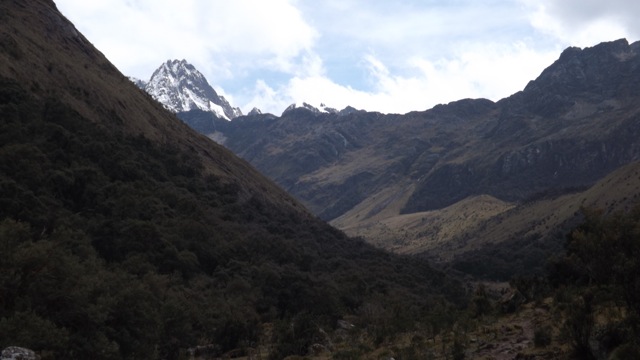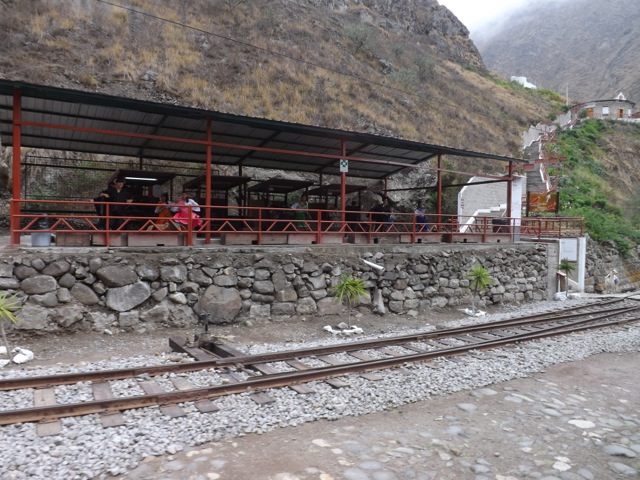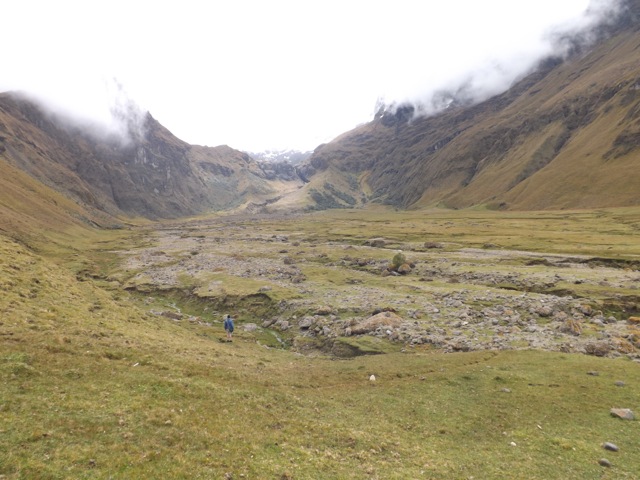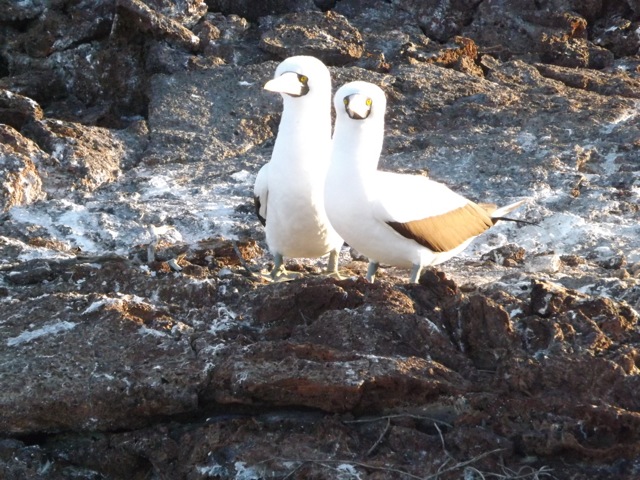While there are many hikes in the Cordillera Blanca, the Santa Cruz hike is the most popular, and is usually done with a guide. Hiking with a guide doesn’t feel like true hiking, especially when they carry half of the equipment, set up tents and prepare your food. So, I decided to do it without one. As it happens, four Americans at my hostel were also planning to go guideless. And while I prefer to hike alone, I wouldn’t be totally alone in the mountains… We booked a bus to the start and prepared to leave early the following morning.
Day 1
Not having a good night’s sleep the night before a hike is a bad thing. I discovered this on the Colca Canyon hike and well, it seemed to happen again!
The bus trip to the beginning of the hike is five hours on a local bus. Unlike the five of us lads, peruvians have short legs, so there was not a lot of room in the bus. The cramped first two hours of the trip was on a sealed road and then the last three hours was to be on a very rocky dirt road. Five minutes onto that dirt road, however, the bus gave up and with black smoke pouring out the side, the transmission fell out. The pool of red transmission fluid under the bus is not obvious in this photo, but it’s there…

After an hour the bus was fixed, but only enough for it to return to base leaving us to wait for another one. Three hours later it arrived and we were on our way again. Three hours of jaw rocking dirt road meant no napping for me!
We were delivered to the small village of Yanama and discovered a group of three girls and a french couple who were also doing the hike without a guide. While the french couple were quite typical of many french people I’ve met in South America so far – they treated us like we didn’t exist and totally avoided us – the three girls decided to join the group. With eight of us, and two particularly chatty girls, my hike was going to be noisier than I wanted. So, I let the other seven head off and dropped to the back to walk alone.
The first part of the hike leads out of Yanama and down the hill via a steep dry track, crossing one dirt road on the way and eventually the river via a concrete bridge. I headed left as the trail widened leading through a couple of villages where every small child ran up and demanded bon-bons. Never give the kids bon-bons!

Finally, I came to my first climb of the day. It wasn’t a large one but my lack of sleep caused me to struggle up it. I met the others at the top and stopped for a rest as they headed off again. I was hoping there wasn’t going to be many more climbs as the direct sunshine on top of my tiredness was draining. But there were a few. Eventually, I rounded a bend in the valley and saw a group of tents a couple of kilometres away and figured this was my companions. I set out towards them, making slow progress across some small hills.

I was getting close to the tents when I came across a pair of cows on the trail, staring me down. Did you know that more hikers are killed every year by cows than anything else? It’s true! Google it. Not wishing to be trampled to death for getting too close, I went around, through a boggy area of ground. Exhausting!

I finally made it to the tents to discover it wasn’t my group but a guide and his party. He pointed me further along the trail, so I struggled on. After another kilometre I still hadn’t located my amigos and with the trail leading up some hills, I picked a spot for a camp near the river and set up my tent. After cooking dinner and getting ready for the next day, I slumped into my sleeping bag and slept.
Day 2
From my planning, I was aware that Day 2 was the most difficult day of the hike. From my camp at 3,800 metres (above sea level) I would walk 13 kilometres and climb nearly a kilometre to a pass called Punta Union at a height of 4,750 metres. Followed by a further 3 kilometres down the other side.
While The Choro trek in Bolivia began 50 metres higher, I only had to climb 100m total before descending on that hike. If that 100m was hard because of the altitude, this one was going to be a very difficult day indeed fighting the altitude the entire way.

I packed up and left my camping spot. After a fairly good sleep, I had more energy, so I set off along the trail with more vigour. But while climbing hills was still hard, it was easier than day 1.

After a kilometre, I found the empty campsite where the other seven had camped. I headed along the valley slowly climbing as I went. As the day progressed I climbed higher along the valley. I consider any height above 3,700m to have a thin atmosphere – with less air pressure. Being a large framed, large lunged person, the higher I went the more trouble I had getting enough air and spent a lot of the time out of breath. There was a point where I had to take a break to catch my breath after every 10 steps; but only when climbing.
I climbed slowly over small knolls and past several tarns – small mountain lagoons, with towering snow covered mountains and glaciers across from me. I came over a knoll to see the ridge line I still had to climb, with the small gap at the top that was the pass.

I continued on and the higher I went, the harder it became. Every five steps I had to take a rest to get my breath back. I even took my pack off every 100m or so for a longer break. As I climbed, my rate got slower and with only about 50 metres to the gap I slowed to only 3 steps before resting. Then for the final few metres it was only one step before resting. So…slow… But I did have a good view back along the valley.

When I finally went through the gap, I passed an altitude marker and slumped down on the other side in the sun, taking my pack off and uttering, ‘Thank f**k for that!”

Down was a lot easier and I powered through the switchbacks below a massive white glacier…

…and above an azure mountain lake.

I could see tents in the distance and marched on feeling more energised that I was no longer climbing. I stopped only once before I arrived at the tents 2-3 kilometres from the gap only to find it was another tour group. So, I walked on across the flat river plains following the river.

Eventually, passing another guided group, I found the tents of my group and set up camp.
Day 3
The main part of Day 3 takes only 3 hours, so to extend it most people climb to Laguna Arhueycocha.
We started the day climbing slightly to a higher valley. Slightly is still difficult at 4,000m.

On reaching the valley we left our packs with covers on as it had rained overnight. Even walking along the high valley without packs wasn’t easy and after a couple of kilometres I arrived exhausted at the base of the wall that climbs up to the laguna. The rest of the group decided to climb it, but I opted to stay at the bottom. I’ve seen plenty of glacier lakes in this trip, so decided to save my energy.

There were some buildings nearby, so I decided to investigate those instead. They were only 50m away, up a climb of about 5 metres, but even that was exhausting. The buildings were empty, but looked to have been a camping area with a place for donkeys. While I was there it began to snow a little.
When the group returned, we headed back down the valley – an easier walk – donned out packs and climbed back down to the main valley. For the rest of the walk, we followed the valley and river along, firstly through a dry river bed thick with sand.

Sand is difficult to walk on carrying a pack. We climbed about 10 metres up the other bank and followed the trail that undulated as it went. We passed along the side of a large laguna and took a break for lunch at the other end as we looked along the valley.

We were to pass another laguna, but it turned out to be little more than a marsh. Perhaps it’s larger in the rainy season. Cows, ponies, horses and donkeys were everywhere as we walked along the sometimes sandy, sometimes rocky trail. Eventually I saw the campsite ahead and marched off, arriving to a set of rocky walls at a place called Llamacorral. I pitched my tent as the others arrived and we began preparing dinner when we got a visit from a pony who decided he didn’t want grass for dinner.

Later, we made a fire in a deep rocky fire pit and sat around talking for the evening.
Day 4
The sky was clear the next day, so after breakfast I packed up my things and headed off, walking ahead of the group for a change. Most of the day saw me walking the rocky track along the side of the valley as the river snaked its way through the landscape. There wasn’t much to see as I walked and after 90 minutes I took a short break off the trail. When I was putting my pack back on, I saw the group go past.

I marched after them, I saw a waterfall opposite which marked the halfway point of the day. For the rest of the walk, the trail descended following the river down through the gorge. With the sun high in the sky and the sandy trail, it was very hot. A distinct contrast from the day before with its slight snow.

An hour later, I rounded a bend to find my group stripping down to their underwear at a nice spot in the river. The gingerly got into the freezing water. I was steaming hot, so I stripped down and threw myself into the river. No wading here, boys and girls, the only way into a freezing river is as quickly as possible. I was out just as quickly though and drying on the side.
Then, we were off again and 20 minutes later arrived at the end of the trail after passing a group of larger people heading back the other way. I wondered how they were going to manage the climbing. They were part of a guided group, so weren’t carrying much gear, but they didn’t look as fit as my group, and we struggled at times.
Five minutes after we’d signed out of the trail, we were walking past a house and the owner rushed out offering us cold soft drinks and beer. He told us he’d call a Collectivo – mini van – for us. It would take us to a larger town where another Collectivo would take us back to Huaraz.
As we were driven away in the van, we could see the gap from which we’d exited the hike and the surrounding landscapes.

Conclusion
Because the trek was at such altitude, it goes down in my books as being the most difficult hike I’ve ever done. With day 2 being the most difficult day’s hike, even more difficult than day three of the Colca Canyon hike. Did my week in Lima at a low altitude cause me to lose the acclimatisation I’d previously gained in Bolivia and Northern Peru? Probably. I should have given it a couple of extra days in Huaraz before I did the hike. But these are the things you learn.
Next, I’m off north to the beach city of Mancora in far northern Peru before crossing the border into Ecuador. I’ll see what adventures await me there.
The Trail Wanderer.




















































































